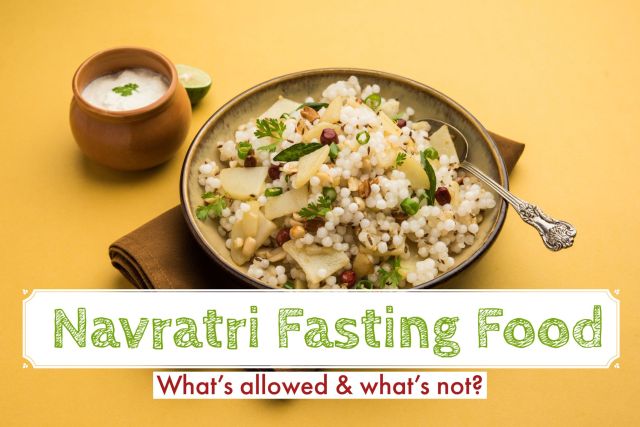The Sooji Halwa recipe is passed on to generations. The recipe of Sooji Halwa brings back a lot of childhood memories. It is served with Poori and Kala Chana at the end of the Navratri fasting season. This is the traditional Ashtami or Navmi Prasad. The combination of halwa, poori, and chana is lip-smacking and mouth-watering.
Indulge in this delightful recipe and end your Navratri season on a sweet note.
Watch YouTube Video
What is the Navratri Festival?
Navratri (also known as Navaratri or Navrate), is a joyous Hindu festival. It is celebrated over 9 to 10 days. “Navratri” is a word from the Sanskrit language – Nav means nine and Ratri means night. This festival is celebrated two times a year, once in the spring (Chaitra Navratri) and once in the autumn (Sharad Navratri). Sharad Navratri falls during September or October and is widely celebrated all across India.
One of the main aspects of Navratri is fasting (known as Vrat or Upvas). During fasting, devotees avoid eating some foods, like grains, pulses, onions, garlic, alcohol, and non-vegetarian items. But they eat fasting food items like fruits, nuts, dairy products, etc.
What food items are allowed in Navratri?
Food items that are allowed during the Navratri season are as follows:
- Vegetables like potato, tomato, arbi, cucumber, carrot, bottle gourd, eggplant, pumpkin, etc.
- Fruits
- Dairy Products
- Coconut
- Nuts and Seeds
- Quinoa, Buckwheat, Little Millet (Samai or Samak), Water Chestnut Flour (Singhade Ka Aata).
- Spices like cumin seeds, red chili powder, turmeric powder, cardamom, carom seeds (ajwain), cinnamon, cloves, black pepper, etc.
- Rock Salt

What food items are not allowed in Navratri?
Food items that are not allowed during the Navratri season are as follows:
- Onion and Garlic: They are Tamsik in nature and hence not consumed.
- Lentils and Pulses like moong dal, chana dal, kidney beans, chickpeas, etc.
- Grains and their flours like wheat flour, gram flour (besan), etc.
- Eggs, Non-Vegetarian Food Items like chicken.
- Alcohol (some people avoid smoking too).
- Salt
- Canned Food Items
Everybody has their own beliefs and follows their own rules during the fasting period. That is why, I suggest you adjust the recipes based on how you follow your fasting and celebrate Navratri.
Tips to make it right
1 – Dry Roasting
This is a new technique that I learned from the Bharatzkitchen YouTube channel. Generally, sooji is roasted with ghee till it turns slightly brown. But dry roasting makes the grains slightly bigger. This way the texture of the Halwa becomes much better. If you roast in ghee directly, it gelatinizes and becomes more paste-like. That also tastes good but dry roasting first improves the texture and the taste.
2 – Stirring Continuously
This job needs a lot of patience and elbow grease. You can’t keep your eyes away while roasting sooji otherwise it will burn. You can’t even keep the flame high to speed up the process. You need to stay calm and keep roasting for 15 minutes till it turns slightly brown. Some people make it white in color. You can save some time and make it like that but roasting it well improves the texture and the taste too.
3 – Amount of Water
This is one recipe where measurement is very important. For water, keep it three times the amount of sooji you are taking. I took 1/2 cup of sooji. So the water is 1.5 cups. Also, add sugar to the water itself and heat it only till the sugar dissolves. Somehow, it tastes much better than directly adding water and sugar in sooji after roasting is done.
What to do if leftover Halwa gets dry?
The leftover sooji halwa gets dry. I simply add a little water and let it cook well for a few minutes till the water is all absorbed or evaporated and I get the right consistency of halwa. Cooking for a little while at this stage is important otherwise you will get the taste of water in the halwa. And don’t worry. It is not rocket science. It is very simple.
Is this recipe vegan-friendly?
No. I am afraid.
This recipe is made using ghee. It doesn’t taste as good when you make halwa with cooking oil. But I am going to try the same recipe with coconut butter. Let’s see how it turns out.
More Navratri Fasting Recipes
- Kuttu (Buckwheat Flour) Cheela
- Quinoa Pulao
- Amaranth and Dates Energy Bars
- Quinoa Cutlets
- Sabudana Thalipeeth
- Sabudana Khichdi
That’s it, my dear friend. You are all ready to make this sooji halwa recipe at home. It is one of the best Indian vegetarian sweet recipes. It is perfect whenever you crave something sweet because it needs very simple ingredients that are easily available in our kitchen. So, grab all the ingredients because you are ready to make a delicious happy meal for yourself.

If you try this recipe, please share your reviews in the comment section below. Do share a photo on Instagram and tag us @thefearlesscooking. We love seeing your recreation of our recipes.
Happy Cooking.
Love from us
Richa & Jatin













Tell us what you think